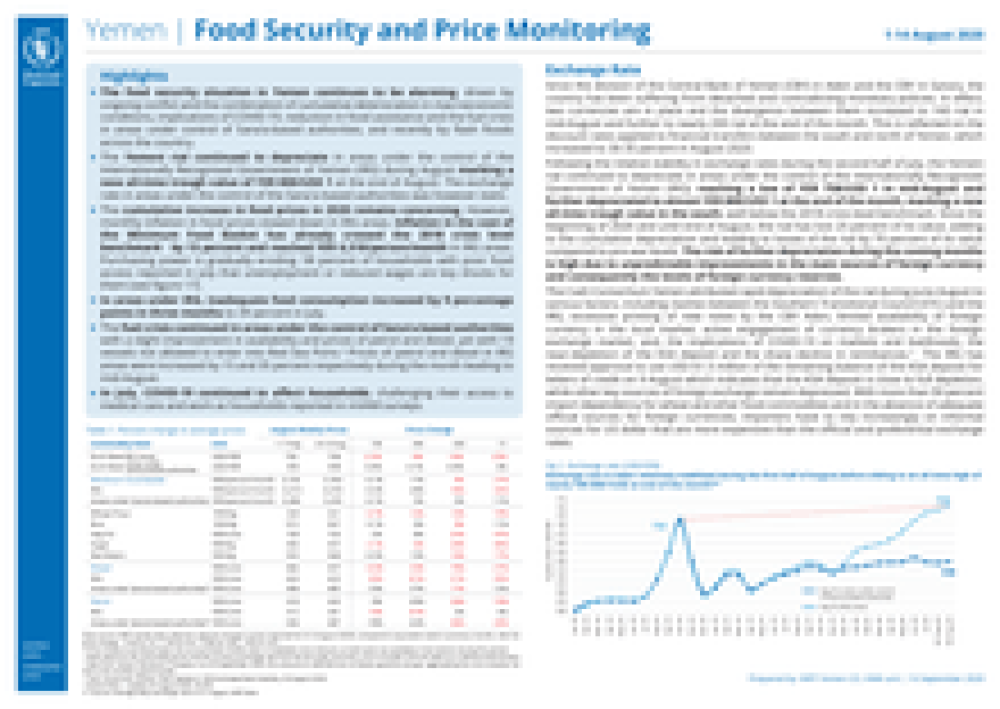Yemen: Food supply chain Update - Thematic report, 2 August 2023


OVERVIEW
Yemen’s dependence on imported food and fuel to meet local demand exposes its citizens to sudden and prolonged changes in international market dynamics, including price hikes and supply disruptions. Local market dynamics, including exchange rate variation, access to local and foreign currency, and specific internal cost drivers (such as price capping), directly affect local food prices. These factors affect household purchasing power and access to food based on affordability. This affordability can fluctuate following local price hikes and reductions.
In 2020, ACAPS analysed the respective food supply chains and cost drivers for essential food commodities imported into Yemen. Given the high consumption levels of wheat-based food items in the country, this analysis focused on wheat. The 2020 report highlighted the significance of many key challenges that traders faced, of which financial challenges, such as exchange rate instability and access to credit, were primary. Other challenges included the competition between the de-facto authority (DFA) in the north of Yemen (also known as the Houthis) and the Internationally Recognized Government of Yemen (IRG) over import financing and increases in overland transportation costs (ACAPS 16/12/2020).
This report provides an update on the main food supply chains and cost drivers in the country, noting any changes that occurred at the international and local levels between January 2021 and June 2023. The most significant changes to international food and fuel price and supply chain dynamics followed the Russian invasion of Ukraine in February 2022. The war in Ukraine and the disruption caused to international fuel and wheat supply and price dynamics had a notable impact on Yemen’s food and fuel supply chains. Yemeni wheat importers experienced reduced access to wheat produced in India, Russia, and Ukraine. Although other sources for bulk wheat were available, international wheat prices rose substantially owing to the disruption to wheat export and crop cycles in Russia and Ukraine and other factors that included a disruptive heatwave in India in March 2022.
International supply disruption often translates to local price increases (ACAPS 25/08/2022;
Markets Insider accessed 18/05/2023 a). Yemeni importers often initially absorb increased costs, but if international food prices remain high for an extended period, the added costs are reflected along the supply chain to the consumer. These costs put additional strain on Yemeni households, many of which have experienced a significant reduction in their purchasing power during the conflict. Reduced purchasing power limits Yemeni households’ access to essential imported food commodities available in the market. Sustained higher international and local food prices then carry the potential to trigger a drop in local demand following increased unaffordability. To tilt the balance back in favour of the consumer, coupled with other suspected political and market-focused motivations, the DFA-run Ministry of Industry and Trade (MOIT) introduced and implemented food price caps in December 2022. The DFArun MOIT then applied and enforced further price reductions in 2023 (MOIT 10/12/2022).

Sana’a – The Houthi-run Special Criminal Court in Sana’a has continued the trial of several former employees of the U.S. Embassy,…

Aden – Southern Transitional Council (STC)-affiliated forces on Saturday rejected accusations issued by Yemen’s General Staff, which cl…

Aden – Aidarus Qassem Al-Zubaidi, President of the Southern Transitional Council (STC) and Vice Chairman of Yemen’s Presidential Leader…